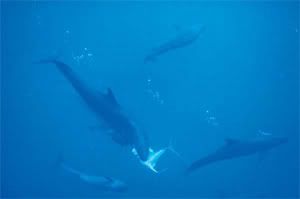
photo credit Dan McSweeny & The Wild Whale Research Foundation
False killer whales actually look nothing like true killer whales. They are smaller, about 15 - 20 feet, and are a plain black. A bit strange looking, but attractive nonetheless. The insular Hawaiian population is of a particular concern - at risk of going extinct within just three generations, or 75 years. Only around 150 animals remain.
Their numbers have probably been decreasing due to certain human-like habits they have...so listen up. They prefer to eat "top predator" fish - tuna, swordfish, mahimahi...which are loaded with toxins traveling and accumulating up the food chain. That and, oh...we're eating all those fish.
Additional factors include bycatch and entanglements from fishing gear, as well as increased anthropogenic development and noise pollution.
False killer whales are social animals. Recently, researcher Dan McSweeny was honored enough to be included in their meal-sharing ritual...which I think might just be the coolest thing ever.
These animals travel and hunt in groups, and when a member of the pod makes a catch, he or she will pass it around and share with the entire group.
"Some just pass the fish on, others take a small bite first, until eventually the prey animal is returned to the hunter who killed it. McSweeney was startled to be included in the exchange. The whale, which was about six feet away, shoved "a chewed-up chunk of ahi in my chest"; then swam below and behind McSweeney, blowing bubbles that rose around his swim fins."
Seriously, how cute is that?!
Full article here (Maui News)
No comments:
Post a Comment